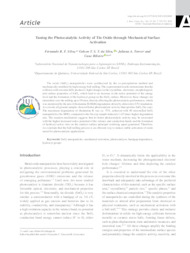Tuning the photocatalytic activity of tin oxide through mechanical surface activation.
Tuning the photocatalytic activity of tin oxide through mechanical surface activation.
Author(s): SILVA, F. B. F.; SILVA, G. T. S. T. da; TORRES, J. A.; OLIVEIRA, C. R. de
Summary: Tin oxide (SnO2) nanoparticles were synthesized by the co-precipitation method and mechanically modified by high-energy ball milling. The experimental results demonstrate that the collision with zirconia balls produces slight changes in the crystalline, electronic, morphological, and surface properties of SnO2, which lead to an increase in the redox potential of the energy level and the formation of the hydroxyl group on the SnO2 surface. Moreover, these changes are intensified over the milling up to 90 min, directly affecting the photocatalytic performance, which was monitored by the rate of rhodamine B (RhB) degradation driven by ultraviolet (UV) irradiation. As a result, all ground samples showed better photocatalytic activity than pristine SnO2 (Sn-cop). The maximum degradation of rhodamine B was ca. 75%, achieved with 90 min-milled SnO2 nanoparticles (Sn-M90), compared to the Sn-cop sample induced a 1.67 times higher degradation rate. The reaction mechanism suggests that its better photocatalytic activity may be associated with the higher increased redox potential of the valence and conduction bands and the formation of hydroxyl active sites on the catalyst surface principal oxidizing agent generated. Therefore, we conclude that the ball milling process is an efficient way to induce stable activation of oxide metal for photocatalytic applications.
Publication year: 2022
Types of publication: Journal article
Unit: Embrapa Instrumentation
Observation
Some of Embrapa's publications are published as ePub files. To read them, use or download one of the following free software options to your computer or mobile device. Android: Google Play Books; IOS: iBooks; Windows and Linux: Calibre.
Access other publications
Access the Agricultural Research Database (BDPA) to consult Embrapa's full library collection and records.
Visit Embrapa Bookstore to purchase books and other publications sold by Embrapa.

